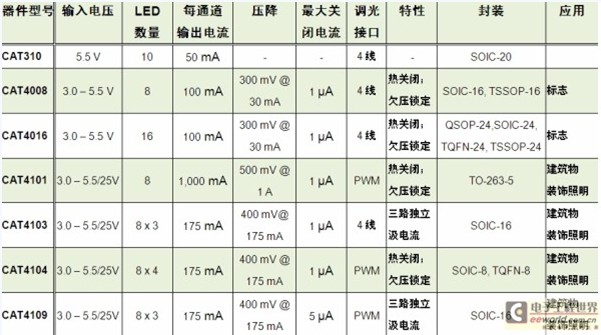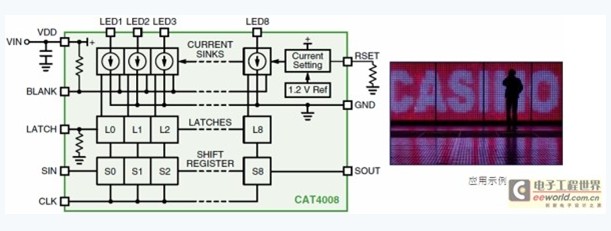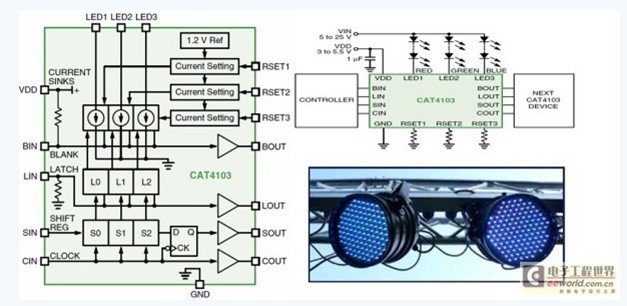With the improvement of LED in almost every aspect of illuminating performance, cost, etc., the application range of LED is more and more wide, but the proportion of penetration in various application fields is different. In commercial applications such as addressable signs and building lighting, LEDs are widely used for their advantages in color, total cost of ownership, longevity, reliability and convenience. For example, in building decorative lighting applications, the use of LEDs can create rich colors on the exterior walls of buildings and better reflect the structure of the building. In the mobile logo app, the traffic display, video images and billboard information can also be updated in real time.
As the premier supplier of high-performance silicon solutions for energy-efficient electronics, ON Semiconductor offers a wide range of LED driver solutions for a wide range of LED applications, including both addressable and building decorative lighting. A series of linear drives for application (see table below). These drivers accurately stabilize the LED current and include a programmable interface for software control. This article will take CAT4008, CAT4103 and CAT9552 as examples to illustrate their main functions and basic working principles, which is convenient for engineers' selection design.

Table 1: ON Semiconductor's range of intelligent LED controls/drivers for signage and building decorative lighting.
Constant current intrusion LED driver for applications such as LED billboards
LED applications such as billboard signs, scrolling banners, smart vehicle signs, and sports scoreboards require multiple LEDs, often containing multiple strings of LEDs, requiring LED drive solutions to provide constant light output, and high current matching accuracy between channels Provide an easy-to-use interface to control different LED channels and have reliable protection. ON Semiconductor's solutions for this type of application include constant current LED intrusion drivers such as the CAT4008 and CAT4106, with the former supporting 8 channels and the latter supporting 16 channels.
Taking CAT4008 as an example, the typical LED channel matching accuracy is ±1.5%, and the LED channel can maintain a steady current state when the output voltage is as low as 0.4V (when the LED current is 2~100 mA), which can be realized in the application design. Higher power efficiency. The left side of Figure 1 shows the block diagram of the CAT4008. For detailed function descriptions of the different pins, see Reference [1]. The device uses eight closely matched 汲 currents to stabilize the LED current for each channel, while the external resistor RSET is used to set the LED channel current to approximately 51 times the RSET current. Because each channel contains independent current sensing circuitry, the CAT4008 provides tight, steady current for all channels. The maximum voltage drop of the LED channel is 0.4 V under most current and supply voltage conditions, helping to improve heat dissipation and improve LED driver efficiency. At power-up, the undervoltage lockout circuit clears all latch and shift register information and sets all outputs to off. Once the undervoltage lockout threshold is reached, the device can be set. The driver delays the activation time of each successive LED output channel by 17 nanoseconds (typical), that is, LED2 is delayed by 17 nanoseconds relative to LED1, LED3 is delayed by 34 nanoseconds relative to LED1, and so on. The delay is introduced when the latch (LATCH) pin is activated, minimizing the inrush current on the LED supply, allowing the use of smaller bypass capacitors.
The high-speed, four-wire (4-Wire) serial interface with speeds up to 25MHz controls each of the eight channels through the shift register and latch architecture. The serial data output pin allows multiple devices to be used in series through the same serial interface. The CAT4008 also has an output shutdown pin that can be used to turn off all LED channels without having to rely on the serial port to send data. In addition, the CAT4008 features thermal protection to turn off the LED output when the die temperature exceeds the allowable limit.

Figure 1: Block diagram and application examples of ON Semiconductor's 8-channel constant current LED intrusion driver CAT4008.
RGB LED pixel driver for high brightness, high visual impact building lighting applications
Some building lighting applications designed to create high visual impact use high-brightness LEDs that require LED drivers to drive high-brightness RGB LEDs and high-speed interfaces to support high data rates and ensure high data integrity Sex, it also needs to have an ultra-low pressure drop to provide higher energy efficiency.
ON Semiconductor's LED drivers for this type of application include the CAT4103 and CAT4109 three-channel constant current RGB LED pixel drivers with independent current control. Among them, CAT4103 is designed for high-end, multi-color, "smart" LED building lighting applications, with high-speed serial interface, can support data rates up to 25 MHz, provides fully buffered data output, ensuring distributed (long distance) Maintain the highest data integrity in a daisy-chained lighting system. The CAT4109 uses a parallel interface with dedicated Pulse Width Modulation (PWM) control for each channel, making it ideal for more conventional LED vision applications such as color mixing and building accent lighting.

Figure 2: ON Semiconductor CAT4103 block diagram, typical application circuit diagram and application examples.
Both the CAT4103 and CAT4109 support a wide range of LED constant current drives up to 175 mA per channel, with a dropout voltage of 0.3 V at 60 mA, ensuring maximum performance when driving long strings of LEDs. These drivers support a voltage level of 25 V per channel and are capable of supporting RGB pixels at high brightness power levels in excess of 10 watts (W).
The CAT4103 and CAT4109 are two products of ON Semiconductor's constant current low dropout driver (LDO) product line. The product line also includes CAT4101 and CAT4104. Among them, CAT4101 provides high precision 1 A current drive capability, while CAT4104 is a Four-channel constant current LED driver for general purpose and building lighting, automotive lighting, LCD backlighting and more.
I2C indicator driver and port expander
Commercially available advertising sales placards, such as flashing LEDs, and various consumer or industrial devices with on/off LED indicators, which need to be able to control individual LEDs to turn on/off individually or at a certain frequency, can be seen on the market. The drive solution, ON Semiconductor's 16-channel I2C LED indicator and port expander CAT9532 and CAT9552 are two products for this type of application.
The CAT9532 and CAT9552 offer a 16-bit parallel input/output (I/O) port expander optimized for LED dimming control. The output can directly drive 16 LEDs in parallel (25 mA per channel), each LED can be individually Turns on, off, or blinks at one of two programmable rates. The I/O of both devices can be used as general purpose I/O (GPIO), and ports that are not used to control the LED can be used as normal ports (see Figure 3).

Figure 3: Typical application circuit diagram for CAT9552.
These devices are suitable for I2C and SMBus applications that need to limit bus traffic or clear bus master timers. Both devices include an internal oscillator and two pulse width modulation (PWM) signals that drive the LED output. The user can set the period and duty cycle of each individual PWM signal. The CAT9532's optional programmable flicker frequency range is 0.593 Hz to 152 Hz, and the CAT9552 is 0.172 Hz to 44 Hz. The duty cycles of the two devices range from 0% to 99.6%. Suitable applications include backlighting, RGB color mixing, and sensor control. , power switch / button, alarm system, office equipment, appliance control panel and point-of-sale (POS) display.
to sum up:
This paper analyzes common LED control applications and their basic requirements for drive/control solutions, and introduces the main products and features of ON Semiconductor for these applications. And ON Semiconductor, the premier supplier of high-performance silicon solutions for energy-efficient electronics, offers LED lighting drivers and PFC solutions ranging from 1 to hundreds of watts, suitable for LED control applications as described herein. Wide range of applications, regardless of whether LED lighting applications use AC-DC power, DC-DC power or battery power, and meet customer requirements for low cost, cost-effective, and energy-efficient.
The main product of Foldable Solar Charger developed by the The FIZZ GLOBAL is solar foldable bag.Solar foldable bag is used to convert solar energy into electricity and then charge digital products through solar panels. It has the advantages of being folding, portable and so on, as well as the demand for electricity in various scenarios such as travel. Solar energy foldable bag is a new high-tech solar energy series products, with intelligent adjustment function, can adjust different output voltage and current. It can charge different charging products, such as MP3.MP4.PDA, digital camera and mobile phone. Solar energy folding bag is small in size, high in capacity and long in service life. It is suitable for the environment of business trip, travel, long-distance bus and ship, field work, etc., as well as the spare power source for students.
The FIZZ GLOBAL solar foldable package can be customized according to customer requirements for size, wattage, different types of solar panels, folding number, output interface, output line and other production.
Foldable Solar Charger
Foldable Solar Charger,Portable Solar Panel Charger,Foldable Mobile Solar Charger,Foldable Solar Panel Charger
ZHEJIANG FIZZ NEW ENERGY CO.,LTD , https://www.ywfizz.com
